Technical Data Drive chain Handling Roller Chains
You can also watch the video to see how to cut/connect roller chain.
Drive chain Maintenance / Handling page
1. How to cut Roller Chain.
The chain needs to be cut to the necessary length.
1.1 Using a chain vise and punch.
- 1. For RP (riveted pin) roller chain, grind down one end of the outer plate's two pins (same side) to the surface of the plate.
Be careful of the chain overheating during the grinding process.
This process is unnecessary for Poly Steel Chain as there are no rivets.
As RS08B-1 to RS16B-1 use easy cutting pins, the rivets do not need to be ground. - 2. Remove the cotter pins for CP (cotter pin) roller chain.
Fig. 1. Rivet-type roller chain
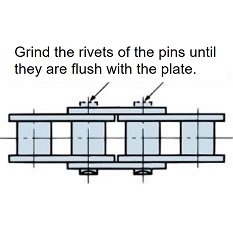
Fig. 2. Grinding the pin ends

- 3. Place the roller chain into the groove of the chain vise and tighten the vise to secure the roller to be disassembled.
Follow 1.3 and 1.4 for Poly Steel Chain and Lambda chain.
For multi-strand Super Roller Chain, place the lowest roller into the groove of the chain vise.Fig. 3. Setting the roller chain in the chain vise

Setting Super Roller Chain
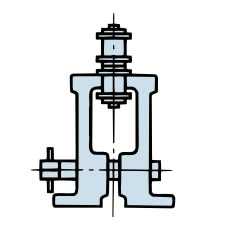
- 4. Place a primary punch, according to chain size, on the head of the ground pin, and then hit the head of the primary punch with a hammer.
Make sure to hit the pins alternatively to ensure the pins are removed evenly and at the same time. Continue to tap the pin until just before the pin is removed from the outer plate.Fig. 4. Tapping the pin with the primary punch
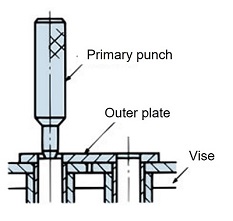
- 5. Use a secondary punch to remove the pin completely from the outer link plate.
1.2 Using a chain breaker
- 1. For RP (riveted pin) roller chain, grind down one end of the outer plate's two pins (same side) to the surface of the link plate. (Same as 1.1)
Remove the cotter pins for CP (cotter pin) roller chain. - 2. Remove the two pins from the same outer plate.
Fig. 5. How to cut a chain using a chain screw

1.3 How to cut Poly Steel Chain.
- 1. Support the outer plate of the chain in the cradle and push down on the pinhead with the exclusive punch. Then lightly hit the head of the punch using a hammer.
- 2. Be careful not to damage the inner links by using excessive force.
Fig. 6. Poly Steel Chain set in a cradle
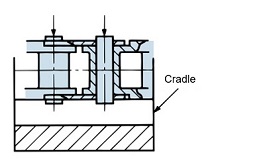
Fig. 7. Cutting Poly Steel Chain
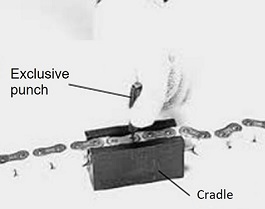
1.4 How to cut Lambda Chain.
- 1. For RP (riveted pin) roller chain, grind down one end of the outer plate's two pins (same side) to the surface of the link plate. (Same as 1.1)
Remove the cotter pins for CP (cotter pin) roller chain. - 2. Then cut the chain using an exclusive cradle and an RS Roller Chain punch. Important points for cutting are outlined in 1.1. However, use an exclusive cradle instead of a vise.
- 3. Hit the pins alternatively when removing the pins with a punch.
⚠Precautions when cutting chain
- 1. Make sure to use a grinder when grinding the riveted portion of one end of the rivet-type pin. If it is extracted without being ground first, more time and effort will be spent, and will damage the chain.
- 2. A chain breaker is a tool made for cutting chain, and can cut roller chain that is set on a machine.
In this case, it is necessary beforehand to support the load on the roller chain and the weight of the roller chain itself to prevent it from falling after being cut. - 3. Check to make sure that the bush where the pin was removed has not come loose or deformed. Do not use if loose or deformed.
- 4. Do not reuse any removed parts.
2. How to connect Roller Chain.
2.1 When connecting chain on sprocket teeth
When connecting roller chain, it is convenient to use the sprocket teeth. Please carry out the following steps.
- 1. Wind the chain around one of the sprockets so that both ends of the chain are facing each other on the sprocket.
- 2. Insert the connecting link in the two end links of the chain.
- 3. Insert the connecting link plate of the connecting link and fasten the plate using the clips/cotter pins or spring pins provided.
- 4. When using an F-type (press-fit) connecting link, insert the connecting link plate by tapping it with a hammer until it moves into position. Then fasten it using the clips/cotter pins or spring pins provided.
- 5. Use protective measures to prevent damage to the teeth when hammering.
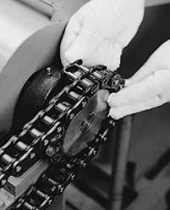
Fig. 8. Connecting on a sprocket
2.2 When connecting between shafts
If a sprocket cannot be used due to layout, follow the procedures below.
- 1. Wind the chain around the sprockets and pull the chain ends together using a chain puller (see Accessories section) or wire.
- 2. Insert the connecting link in the two end links of the chain.
- 3. Insert the connecting link plate of the connecting link and fasten the plate using the clips/cotter pins or spring pins provided.
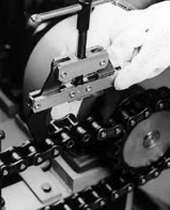
Fig. 9. Connecting between shafts
2.3 Clip・Cotter pin
1. Clip
Clips are used for roller chain (under RS60) connecting links.
When connecting the chain, the clip should be inserted securely into the slot of the pin on the connecting link after the connecting plate has been inserted on the pin.
If the legs of the clips are spread too far they will not catch properly and will fall off during operation of the chain.
The clip is generally installed opposite to the direction of travel for the chain as shown in Fig. 10.
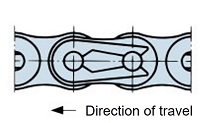
Fig. 10. Direction in which the clip is installed
2. Cotter pin
Tsubaki cotter pins are heat treated, except for on certain corrosion-resistant chains and specialty roller chains.
The legs of the cotter pin should be bent approx. 60 degrees. Cotter pins should not be reused, and commercially available cotter pins other than those produced by Tsubaki should be avoided.

Fig. 11. Attaching clips and pins
RS Roller Chain cotter pin dimensions (Exclusively for roller chain )
| Size | Nominal cotter pin dimension |
|---|---|
| RS35 | 1 × 6 |
| RS40 | 1 × 6 |
| RS50 | 1.6 × 8 |
| RS60 | 2 × 10 |
| RS80 | 2.5 × 14 |
| Size | Nominal cotter pin dimension |
|---|---|
| RS100 | 2.5 × 20 |
| RS120 | 3 × 23 |
| RS140・RS160 | 4 × 24.5 |
| RS180 | 5 × 32 |
| RS200 | 5 × 37 |
Note) Cotter pins unavailable for RS240.
⚠Precautions when connecting chain
- 1. Avoid using offset links wherever possible. Adjust slack by varying the center distance between shafts or using an idler.
- 2. Avoid adjusting chain length by cutting out links from chains that have stretched as a result of elongation wear.
- 3. In the case of pins and connecting link plate holes being press-fit type with F-type or other connecting links, widening the connecting link plate hole or narrowing the pin diameter will result in a reduction in roller chain strength.
Avoid any additional work. - 4. Do not reuse outer plates that have been detached, as the detachment results in a reduction in strength.
- 5. Normally, only an anti-rust oil is applied to individual parts such as connecting links and offset links. When assembling these into the chain, apply lubricant to the surface of pins and bushing holes.

